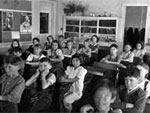At a Glance
Description
The Grammar of History Textbooks, Part I: Language Analysis

Do your students groan that the textbook is boring or difficult? Do they say it contains too many facts and not enough explanation? It may be that they are unfamiliar with the academic language that history textbooks use. Academic language differs from everyday language. It uses abstract words and complicated sentence structures. Reading a history textbook can be a challenge for English language learners and native speakers alike.
Getting Meaning Through Language Analysis is a strategy that linguists Mary Schleppergrell and her colleagues developed while working with middle school and high school history teachers and students. This technique works well for short textbook passages with important standards-related material. Students identify the grammatical elements of each sentence and see how the elements relate. In the process, they not only develop literacy skills but also notice the choices textbook authors make in presenting historical meaning.
Analyzing a short passage, students identify all verbs and place them in one of three categories. The three types of verbs are
- action verbs such as fight, defend, build, vote, and so forth
- saying and thinking-feeling verbs such as said, expressed, suppose, like, resent, and so forth
- relating verbs such as is, have, is called, and so forth
In addition to categorizing verbs, students identify all participants (that is, the subjects and objects of the verbs). They define abstractions such as "Congress" or "the cotton economy."
Once students have identified the verbs and participants, they can begin to understand how the elements of a sentence work together. For example, clauses with action verbs show who is acting upon whom, clauses with saying-thinking verbs present sayers or experiencers with different points of view, and clauses with relating verbs establish background or description.
Example
To focus on the events in a text, teachers can lead students in charting each sentence's action verbs and participants using categories defining the following:
- Agent, or doer of the action
- Action
- Receiver of the action
To identify different points of view in a textbook, try the same kind of analysis with saying-thinking verbs. To highlight information a text presents as background, focus on the relating verbs.
Academic language is different from the everyday language that students use. By carefully analyzing the textbook's prose, both English language learners and native speakers gain fluency and confidence in accessing the textbook's information.
Further, students begin to see how textbook authors construct meaning through their language choices. For example, by identifying agents, actions, and receivers, students begin to notice if one group is always portrayed as being acted upon rather than as taking an active role and shaping their own destiny. In evaluating how an historian constructed the textbook's narrative, students begin to imagine other narratives that might have been constructed in its place.
Mary J. Schleppegrell, Mariana Achugar, and Teresa Oteíza, "The Grammar of History: Enhancing Content-Based Instruction Through a Functional Focus on Language," TESOL Quarterly 38, no. 1 (Spring, 2004): 6793.
This project is also discussed in another article on this website.